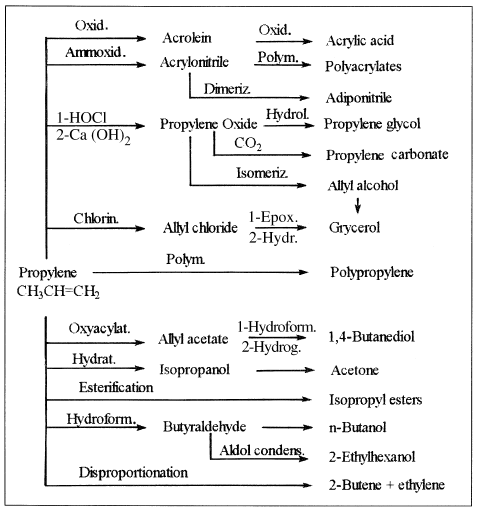


 علم الكيمياء
علم الكيمياء 
 الكيمياء التحليلية
الكيمياء التحليلية 
 الكيمياء الحياتية
الكيمياء الحياتية 
 الكيمياء العضوية
الكيمياء العضوية 
 الكيمياء الفيزيائية
الكيمياء الفيزيائية
 الكيمياء اللاعضوية
الكيمياء اللاعضوية 
 مواضيع اخرى في الكيمياء
مواضيع اخرى في الكيمياء
 الكيمياء الصناعية
الكيمياء الصناعية |
Read More
Date: 13-8-2017
Date: 3-7-2019
Date: 31-7-2017
|
Propylene, “the crown prince of petrochemicals,” is second to ethylene as the largest-volume hydrocarbon intermediate for the production of chemicals.
As an olefin, propylene is a reactive compound that can react with many common reagents used with ethylene such as water, chlorine, and oxygen. However, structural differences between these two olefins result in different reactivities toward these reagents. For example, direct oxidation of propylene using oxygen does not produce propylene oxide as in the case of ethylene. Instead, an unsaturated aldehyde, acrolein, is obtained. This could be attributed to the ease of oxidation of allylic hydrogens in propylene. Similar to the oxidation reaction, the direct catalyzed chlorination of propylene produces allyl chloride through substitution of allylic hydrogens by chlorine. Substitution of vinyl hydrogens in ethylene by chlorine, however, does not occur under normal conditions.
The current chemical demand for propylene is a little over one half that for ethylene. This is somewhat surprising because the added complexity of the propylene molecule (due to presence of a methyl group) should permit a wider spectrum of end products and markets. However, such a difference can lead to the production of undesirable by-products, and it frequently does. This may explain the relatively limited use of propylene in comparison to ethylene. Nevertheless, many important chemicals are produced from propylene. The 1997 U.S. propylene demand ws 31 billion pounds and most of it was used to produce polypropylene polymers and copolymers (about 46%).
Other large volume uses are acrylonitrile for synthetic fibers (Ca 13%), propylene oxide (Ca 10%), cumene (Ca 8%) and oxo alcohols (Ca 7%).

Figure 1.1. Important chemicals based on propylene.
Figure 1.1 shows the important chemicals based on propylene. The following discusses the chemistry of the production of these chemicals.



|
|
|
|
التوتر والسرطان.. علماء يحذرون من "صلة خطيرة"
|
|
|
|
|
|
|
مرآة السيارة: مدى دقة عكسها للصورة الصحيحة
|
|
|
|
|
|
|
نحو شراكة وطنية متكاملة.. الأمين العام للعتبة الحسينية يبحث مع وكيل وزارة الخارجية آفاق التعاون المؤسسي
|
|
|